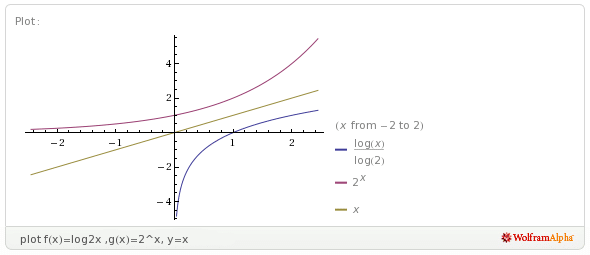Course:MATH110/Archive/2010-2011/003/Groups/Group 14/Basic
Basic Skills Project - Logarithmic Functions
Definition of Logarithms
Let a > 0, a cannot equal 1. Then is the number to which you raise a to get x
Example 1: Show that
Solution: Here the base is 2 and x = 8, to what number should we raise 2 to get 8, well gives us 8.
What if we don’t know what the x value is??
Example 2:
Solution: Write 32 as a power of 2, 32= 2*2*2*2*2, so is the answer
Example 3:
Solution: Write 81 as a power of 3, 81= 3*3*3*3, so
From the above examples it follows that when dealing with logarithms there are two forms to consider:
a.) Exponential Form
where a is the base, b is the exponent, c is the product
b.) Logarithm Form
where a is the base, b is the exponent, c is product
Laws of Logarithms
When we are required to solve equations or simplify equations we can refer to the Log Laws.
Let a > 0, a cannot equal 0, and let x > 0 and y > 0. Then:
1.
2.
3.
4.
Example 1: Solve
Solution: Using rule 1
We can rewrite the logarithm expression as
Converting this into Exponential form we get
Solve for x:
Example 2: Solve
Solution: This is an example in which the laws of Logarithms aren't used. It shows that even though these laws exist exponential and logarithm forms are the simplest methods to use in this case.
In exponential form we get:
Because the exponents are equal to each other therefore the bases must equal each other
Make the equation equal to zero and solve for x:
or
Logs as Inverses of Exponential Functions
Recall that f and g are called inverse to each other if the following are true:
1. f(g(x))= x
2. g(f(x))= x
3. domain of f= range of g
4. domain of g= range of f
Theorem
Let a> 0, and a can’t equal 1. Then and are inverse to eachother.
If you let and , you can examine the first two conditions above.
1.f(g(x)=. What does this mean? It’s a, raised to the number to which you raise a to get x. So it equals x.
2.g(f(x))=
So and undo each other.
Now to get a better look at this we can graph the functions and and flip them around the line y=x.

Notice that the domain of is the set of all positive numbers, and the range is the set of all real numbers. Where as domain is the set of all real numbers, and the range is the set of all positive numbers.
The following examples show some of the problems you may encounter.
Example 1: Solve
We know that the function undoes the action of that log function. So applying:
f(x)= to gives us , which we know is equal to x, and applying to 4 gives us . So:
Therefore x= 16
Example 2: Solve
Now to solve we apply to both sides.
So
Group 14's YouTube Channel
We have added some videos about logarithmic functions that we have found useful. You can view our Logarithmic Functions playlist here:
Practice Set 1: Logarithmic Functions
Evaluate the following. If you get stuck, try the hints first before looking at the solutions:
1)
2)
3)
4)
5)
Hints:
1) Review the definition of the logarithm above. The base here is __ and x = __.
2) Review the definition of the logarithm above. The base here is __ and x = __.
3) This one is trickier because it contains a fraction. Treat it the same as the others. The base is __ and x = __. the value ________ (increases or decreases). Therefore, if you raise a fraction to a negative power, the value ________(increases or decreases).
4) Here the base is a fraction. When you raise a fraction to a positive power, the value ________ (increases or decreases). Therefore, if you raise a fraction to a negative power, the value ________(increases or decreases).
5) This one is trickier because it contains a fraction. Treat it the same as the others. The base is __ and x = __.
Solutions:
1) 2
2) 2
3) -1
4) 8
5) -4
Practice Set 2: Logs as Inverses of Exponential Functions
Solve the Following
1)
2)
3)
4)
5)
Hints
1)2 to what power is 64? then make that power equal x-3 and solve for x
2)3 to what power is 27? then make that power equal x+1 and solve for x
3)4 to what power is 16? then make that power equal 2x-3 and solve for x
4)5 to what power is ? then make that power equal x+5 and solve for x
5)3 to what power is 27? then make that power equal x-2 and solve for x
Answers
1)x = 9
2)x = 2
3)x =
4)x = -8
5)x = 5
Practice Set 3: Laws of Logarithms
Solve the Following:
1)
2)
3)
4)
Hints:
1) Refer to the log law that multiplies the variables.
2) Once you have applied the appropriate log rule try manipulating the equation so, in its exponential form, it is equal to zero.
3) Change the base to base___.
4) What is your base in this equation? Pull out the exponent _____.
Solutions:
1) x = 2
2) x = 9 or x = -3
- the solution to this problem is call an Extraneous Solution. Because the result is two answers, check to see if they satisfy the original equation; one of the above solutions is incorrect.
3) ~1.26
- without a calculator the answer to this question will be in fraction form
4) x = 5 or x = -2
- the solution to this problem is call an Extraneous Solution. Because the result is two answers, check to see if they satisfy the original equation; one of the above solutions is incorrect.




























































